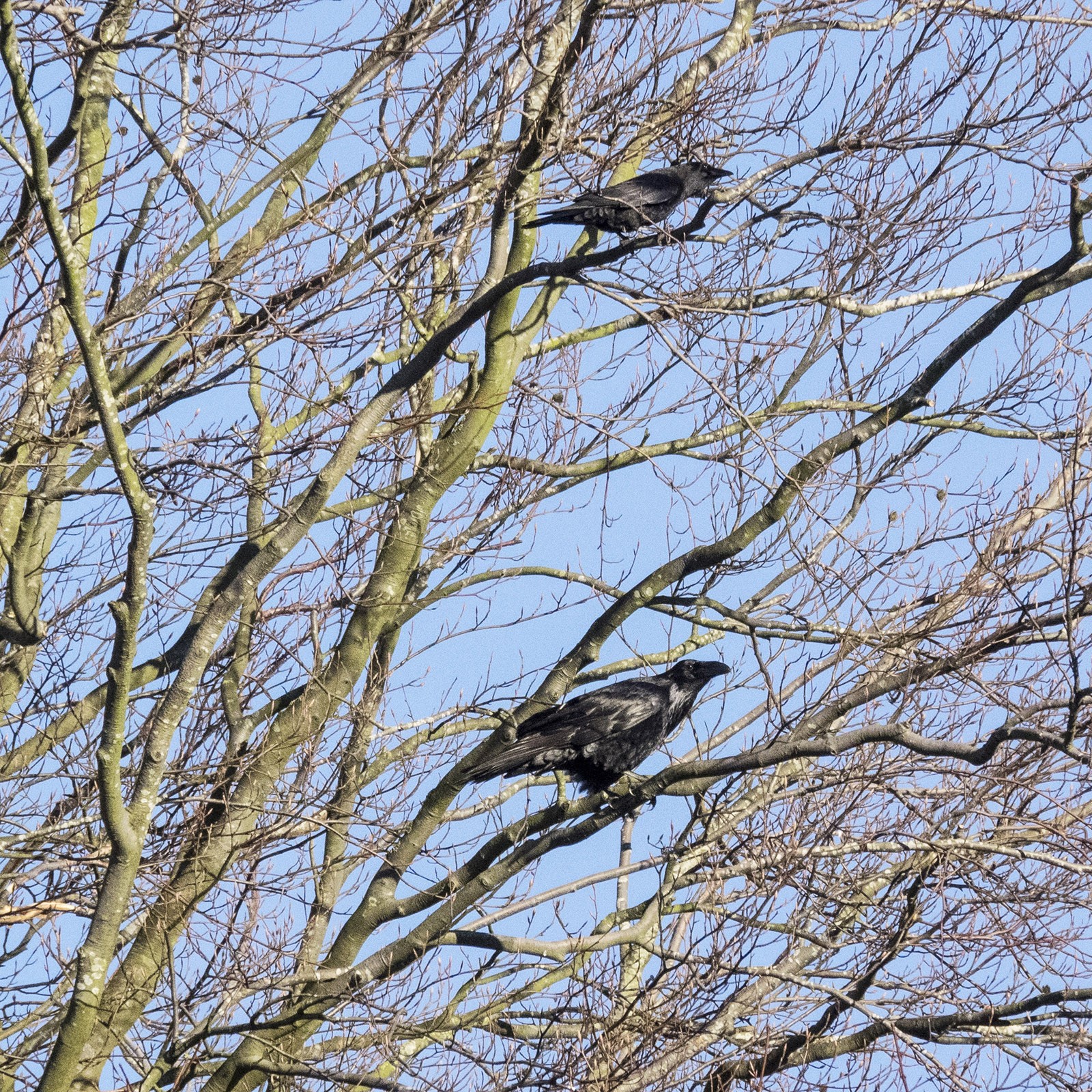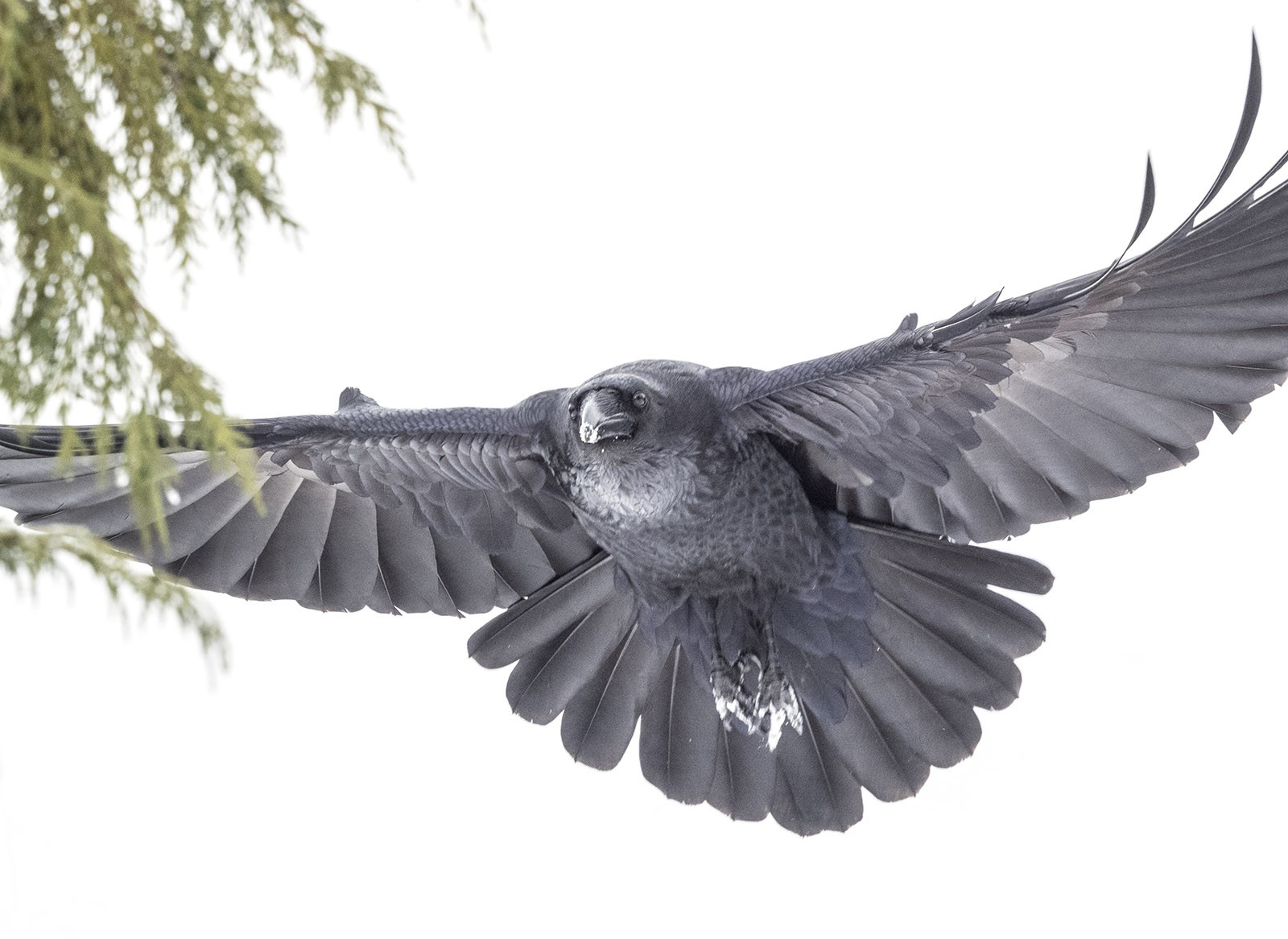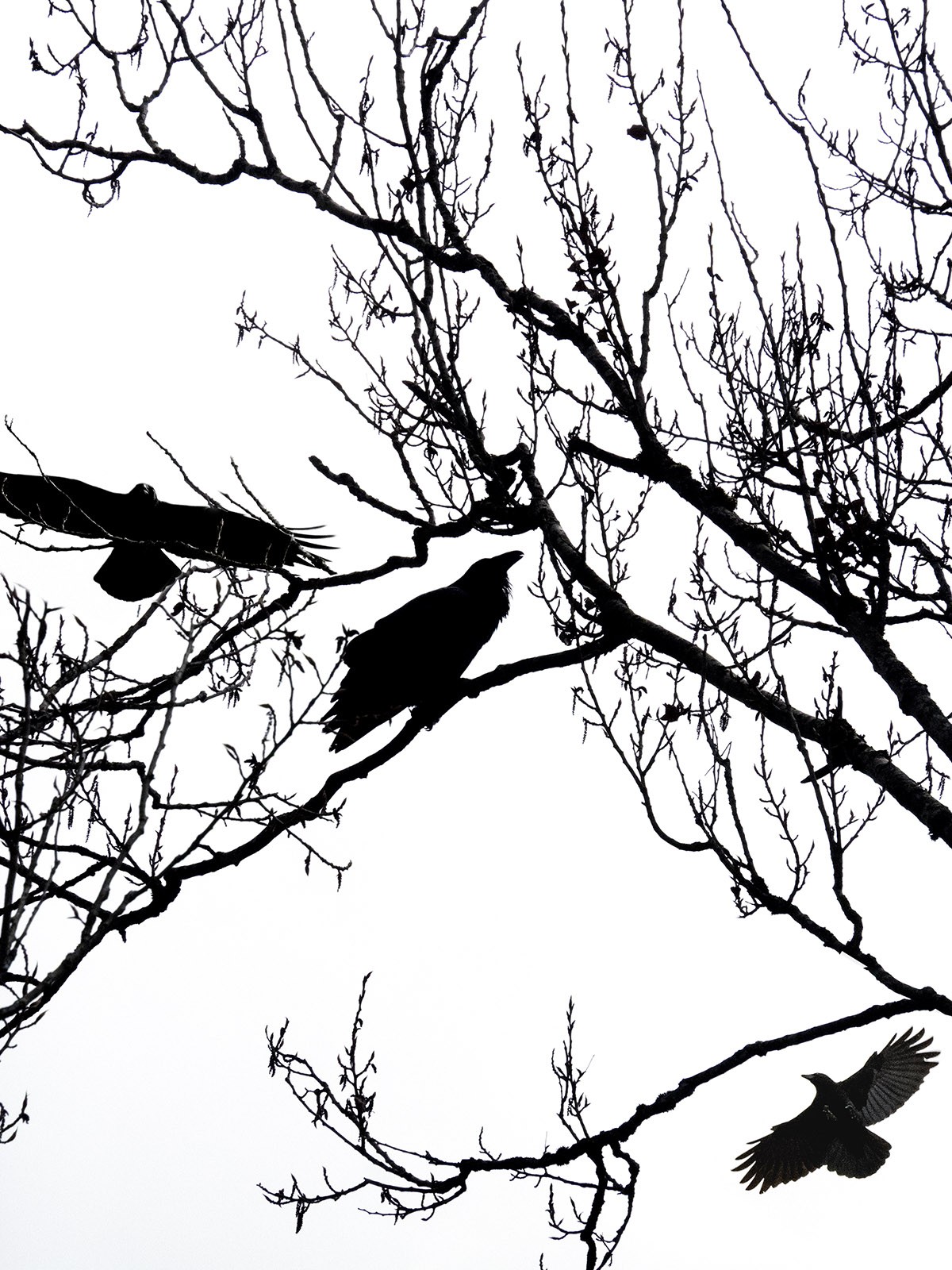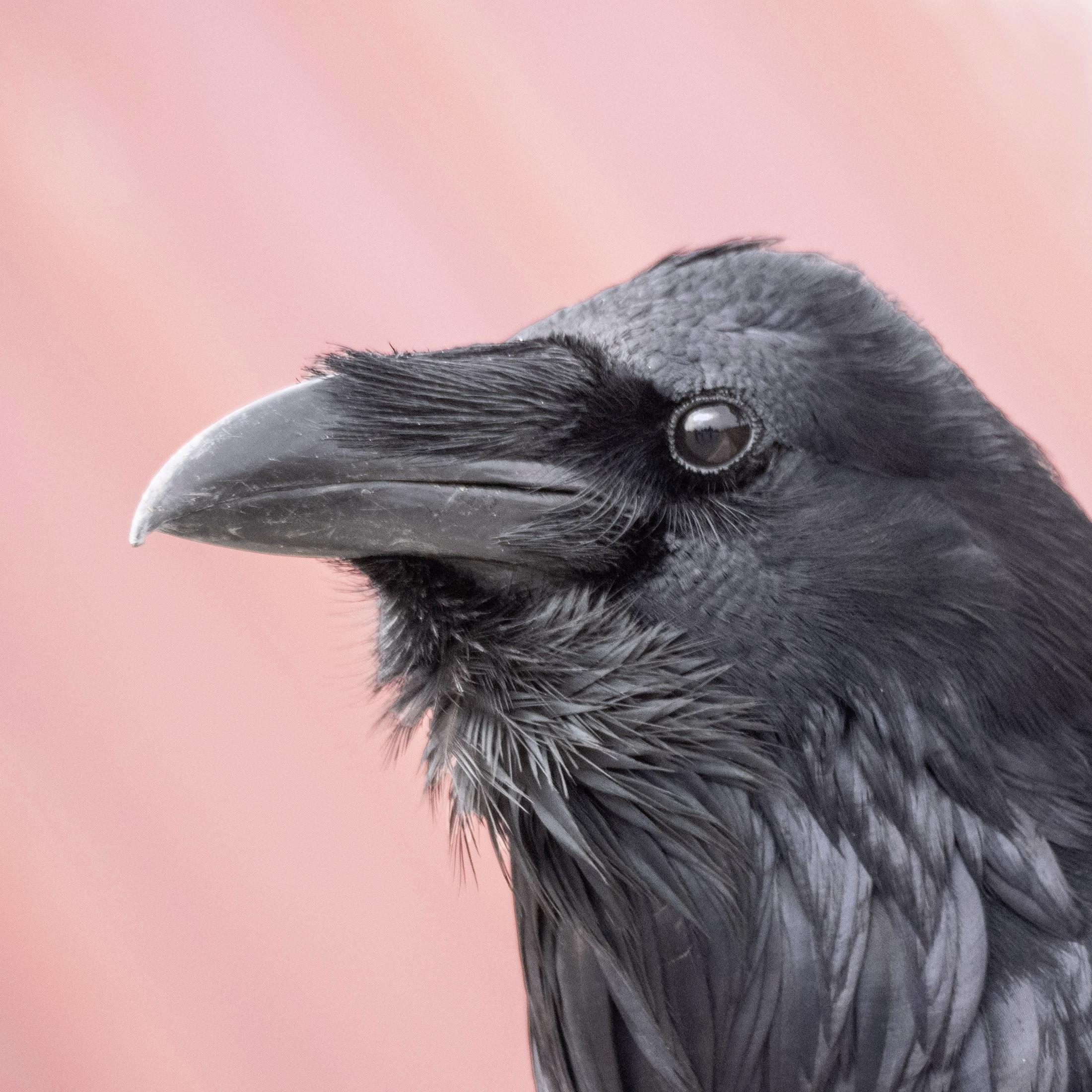Compare Ravens And Crows, two of the most intelligent and charismatic birds, can be challenging. This comprehensive guide from COMPARE.EDU.VN breaks down the key differences in size, sound, behavior, and physical traits, offering a clear understanding of how to distinguish these often-confused corvids. Explore vocalizations, social dynamics, and flight patterns to confidently identify crows versus ravens. Want to know how to tell a rook from a raven? Find out more information and compare similar birds.
1. Understanding the Basics: What Are Ravens and Crows?
Ravens and crows both belong to the Corvidae family, which also includes jays, magpies, and other intelligent birds. They share many similarities, such as their black plumage and intelligence, which often leads to confusion. However, understanding their distinct characteristics can help you tell them apart. This guide will explore the key differences between ravens and crows, from their size and physical features to their behavior and vocalizations.
1.1. What defines a raven?
Ravens (Corvus corax) are among the largest and most intelligent of all birds. Known for their glossy black plumage, heavy beaks, and distinctive croaking calls, they are found across a wide range of habitats, from deserts and forests to coastal areas and mountains. Ravens are highly adaptable and can thrive in both wild and urban environments.
1.2. What defines a crow?
Crows, particularly the American crow (Corvus brachyrhynchos), are smaller than ravens and have a more slender build. They are also highly intelligent and adaptable, commonly found in agricultural fields, suburban areas, and urban parks. Crows are known for their distinctive cawing sound and their social behavior, often gathering in large flocks, especially during migration and winter.
2. Size and Physical Features: How Big Are Ravens Compared to Crows?
One of the most noticeable differences between ravens and crows is their size. Ravens are significantly larger, often appearing almost twice the size of crows.
2.1. Detailed size comparison
| Feature | Raven (Corvus corax) | American Crow (Corvus brachyrhynchos) |
|---|---|---|
| Length | 24-27 inches (61-69 cm) | 17-20 inches (43-51 cm) |
| Wingspan | 45-50 inches (114-127 cm) | 33-39 inches (84-99 cm) |
| Weight | 2-4 pounds (0.9-1.8 kg) | 0.7-1.3 pounds (0.3-0.6 kg) |
| Body Build | Heavier, more robust | Slender, more streamlined |
| Beak | Thick, curved | Thinner, straighter |
| Throat Feathers | Shaggy, prominent | Smooth |





Ravens, being larger, have a more powerful presence, which is often reflected in their behavior and flight.
2.2. Distinguishing features: Beaks and feathers
The physical features of ravens and crows provide additional clues for identification. Ravens have heavier, more curved beaks compared to the thinner, straighter beaks of crows. Additionally, ravens often exhibit shaggy throat feathers, sometimes referred to as a “beard,” which are less prominent in crows.
3. Flight Patterns: Soaring vs. Flapping
Observing the flight patterns of these birds can also help in distinguishing between them. Ravens are known for their graceful soaring abilities, while crows tend to flap more consistently.
3.1. How ravens soar
Ravens often utilize air currents to soar effortlessly over long distances. Their broad wings and relatively light weight allow them to take advantage of thermals and updrafts, enabling them to glide and circle without flapping. This soaring behavior is particularly noticeable in open areas such as mountains and coastal regions.
3.2. How crows flap
Crows, on the other hand, rely more on flapping their wings for propulsion. While they are capable of short glides, they typically flap more frequently and for longer durations compared to ravens. This flapping flight pattern is more commonly observed in crows inhabiting agricultural and urban environments.
4. Vocalizations: Cawing vs. Croaking
Perhaps the most reliable way to distinguish ravens from crows is by their vocalizations. Crows are known for their classic “caw-caw” sound, while ravens produce a deeper, more guttural croaking sound.
4.1. Understanding crow calls
Crows typically produce a series of sharp, repetitive caws. These calls are used for a variety of purposes, including communication with other crows, warning of danger, and establishing territory. Crow vocalizations can vary slightly depending on the context and the individual bird, but the characteristic cawing sound remains a consistent identifier.
4.2. Understanding raven calls
Ravens, in contrast, emit a range of vocalizations, including croaks, gurgles, and even bell-like sounds. Their most common call is a deep, resonant croak, which is distinctly different from the cawing of crows. Ravens also use vocalizations to communicate with each other, defend territory, and attract mates.
4.3. Audio examples
- Crow Call: A series of sharp, repetitive caws.
- Raven Call: A deep, resonant croak.
- Other Raven Sounds: Gurgles and bell-like tones.
5. Behavior and Social Dynamics: Solitary vs. Social
Ravens and crows exhibit differences in their social behavior, which can provide additional clues for identification.
5.1. Raven behavior
Ravens tend to be more solitary or live in pairs, especially during the breeding season. They are territorial and will defend their territory against other ravens. While ravens may gather in small groups at food sources or roosting sites, they do not typically form large flocks like crows. Their playful behavior, such as tumbling in the air or playing with objects, is also a notable characteristic.
5.2. Crow behavior
Crows are highly social birds that often gather in large flocks, particularly during migration and winter. These flocks can consist of hundreds or even thousands of individuals, providing safety in numbers and facilitating communication. Crows also engage in cooperative breeding, where young birds help their parents raise subsequent broods.
5.3. Mobbing behavior
One common behavior that can help distinguish ravens from crows is mobbing. Crows often mob larger predators, including ravens, by gathering around them and calling loudly to harass them. This behavior is a form of defense and can indicate the presence of a raven in an area dominated by crows.
6. Habitat and Range: Where Do Ravens and Crows Live?
Understanding the habitat and range of ravens and crows can further aid in their identification.
6.1. Raven habitat
Ravens are found in a wide variety of habitats, including forests, deserts, mountains, and coastal areas. They are highly adaptable and can thrive in both wild and urban environments. In North America, ravens are more common in the western and northern regions, while crows are more prevalent in the eastern and southern regions.
6.2. Crow habitat
Crows are also adaptable but tend to prefer agricultural fields, suburban areas, and urban parks. They are less common in dense forests and high-altitude environments compared to ravens. Crows are widespread throughout North America, with different subspecies occupying various regions.
7. Intelligence and Problem-Solving: Which Bird Is Smarter?
Both ravens and crows are known for their exceptional intelligence and problem-solving abilities. Studies have shown that these birds are capable of complex cognitive tasks, including tool use, planning, and social learning.
7.1. Raven intelligence
Ravens have demonstrated remarkable problem-solving skills in controlled experiments. They can solve puzzles, use tools to obtain food, and even plan for future events. Ravens are also known for their ability to remember and recognize individual humans, indicating a high level of social intelligence.
According to a study by Bernd Heinrich at the University of Vermont, ravens display behaviors suggesting advanced cognitive abilities, such as strategic thinking and anticipation.
7.2. Crow intelligence
Crows are equally intelligent, exhibiting a range of problem-solving behaviors. They have been observed using tools to forage for food, such as using sticks to extract insects from tree bark or dropping nuts onto roads to be cracked by cars. Crows also possess excellent spatial memory, allowing them to remember the locations of stored food items over long periods.
According to research by John Marzluff at the University of Washington, crows can recognize human faces and remember past interactions, influencing their behavior toward specific individuals.
8. Cultural Significance: Ravens and Crows in Mythology and Folklore
Ravens and crows have played significant roles in mythology and folklore across various cultures.
8.1. Ravens in mythology
In many cultures, ravens are associated with magic, mystery, and transformation. In Norse mythology, Odin had two ravens, Huginn (thought) and Muninn (memory), who flew around the world and reported back to him. Ravens are also prominent in Native American mythology, often depicted as tricksters or creators.
8.2. Crows in folklore
Crows, while also respected for their intelligence, are sometimes associated with negative omens or bad luck in folklore. However, they are also seen as symbols of wisdom, adaptability, and resourcefulness in some cultures.
9. Hybridization: Can Ravens and Crows Interbreed?
While ravens and crows are closely related, hybridization between the two species is rare.
9.1. Genetic compatibility
Ravens and crows are genetically distinct, and their chromosomes are not fully compatible. This genetic incompatibility makes successful hybridization unlikely.
9.2. Behavioral barriers
Even if hybridization were possible, behavioral barriers would likely prevent it. Ravens and crows have different mating rituals, vocalizations, and social behaviors, which would make it difficult for them to recognize each other as potential mates.
10. Tips for Identification in the Field: A Quick Guide
To summarize, here’s a quick guide to help you distinguish ravens from crows in the field:
- Size: Ravens are significantly larger than crows.
- Flight: Ravens soar more, while crows flap more.
- Vocalizations: Ravens croak, while crows caw.
- Throat Feathers: Ravens have shaggy throat feathers.
- Social Behavior: Ravens are more solitary, while crows form large flocks.
- Habitat: Ravens prefer forests and mountains, while crows prefer agricultural fields and urban areas.
11. Compare Ravens and Crows: A Table for Quick Reference
| Feature | Raven (Corvus corax) | American Crow (Corvus brachyrhynchos) |
|---|---|---|
| Size | Larger (24-27 inches) | Smaller (17-20 inches) |
| Wingspan | Wider (45-50 inches) | Narrower (33-39 inches) |
| Flight | Soaring | Flapping |
| Vocalizations | Croaking | Cawing |
| Beak | Heavy, curved | Thinner, straighter |
| Throat Feathers | Shaggy | Smooth |
| Social Behavior | Solitary or pairs | Large flocks |
| Habitat | Forests, mountains, deserts | Agricultural fields, urban areas |
| Intelligence | High | High |
| Cultural Significance | Magic, mystery | Wisdom, adaptability |
12. Expert Opinions on Raven and Crow Identification
Several experts have shared their insights on how to differentiate between ravens and crows.
12.1. John Marzluff
John Marzluff, a renowned expert in avian social behavior and crow intelligence at the University of Washington, emphasizes the importance of observing behavior and social dynamics. According to Marzluff, crows are highly social and often form large flocks, while ravens tend to be more solitary or live in pairs.
12.2. Bernd Heinrich
Bernd Heinrich, a biologist known for his studies on raven behavior, suggests focusing on vocalizations and flight patterns. Heinrich notes that ravens produce a distinctive croaking sound, while crows caw. Additionally, ravens are more likely to soar and glide, while crows rely more on flapping.
12.3. Kevin McGowan
Kevin McGowan from Cornell University’s Bird Lab highlights the importance of size and physical features. McGowan points out that ravens are significantly larger than crows and have heavier beaks and shaggy throat feathers.
13. Addressing Common Misconceptions About Ravens and Crows
Despite their intelligence and cultural significance, ravens and crows are often misunderstood.
13.1. Misconception 1: They are pests
While ravens and crows can sometimes cause problems in agricultural or urban settings, they are not inherently pests. They play important roles in the ecosystem, such as controlling insect populations and scavenging carcasses.
13.2. Misconception 2: They are bad omens
In some cultures, ravens and crows are associated with negative omens or bad luck. However, these associations are based on superstition rather than scientific evidence. Ravens and crows are intelligent and adaptable birds that deserve respect and appreciation.
14. The Impact of Ravens and Crows on the Ecosystem
Ravens and crows play important roles in maintaining the health and balance of ecosystems.
14.1. Scavenging
Both ravens and crows are scavengers, feeding on carrion and helping to remove dead animals from the environment. This scavenging behavior helps to prevent the spread of disease and maintain overall ecosystem health.
14.2. Insect control
Ravens and crows also consume large quantities of insects, including agricultural pests. This insect control helps to protect crops and reduce the need for chemical pesticides.
14.3. Seed dispersal
Crows and ravens can aid in seed dispersal by consuming fruits and berries and then depositing the seeds in new locations. This seed dispersal helps to promote plant growth and maintain biodiversity.
15. Modern Research and Studies on Ravens and Crows
Ongoing research continues to shed light on the intelligence, behavior, and ecology of ravens and crows.
15.1. Cognitive studies
Recent studies have focused on the cognitive abilities of ravens and crows, including their capacity for planning, problem-solving, and social learning. These studies have revealed that ravens and crows are among the most intelligent birds on the planet.
15.2. Ecological studies
Ecological studies have examined the role of ravens and crows in ecosystems, including their impact on prey populations, scavenging behavior, and seed dispersal. These studies have highlighted the importance of ravens and crows in maintaining ecosystem health.
15.3. Genetic studies
Genetic studies have explored the evolutionary relationships between ravens and crows, as well as their adaptations to different environments. These studies have provided insights into the origins and diversification of these fascinating birds.
16. How Urbanization Affects Raven and Crow Populations
Urbanization has had a significant impact on raven and crow populations, with some species thriving in urban environments while others struggle.
16.1. Adaptation to urban environments
Crows, in particular, have adapted well to urban environments, taking advantage of food sources such as garbage, pet food, and discarded scraps. They have also learned to navigate urban landscapes and avoid hazards such as traffic and predators.
16.2. Challenges in urban areas
Despite their adaptability, ravens and crows also face challenges in urban areas, including habitat loss, pollution, and human disturbance. These challenges can negatively impact their populations and overall health.
17. Conservation Status and Efforts for Ravens and Crows
While ravens and crows are generally not considered threatened or endangered, some species face conservation challenges.
17.1. Conservation concerns
Habitat loss, pollution, and human disturbance can negatively impact raven and crow populations in certain areas. Conservation efforts are needed to protect their habitats and ensure their long-term survival.
17.2. Conservation efforts
Conservation efforts may include habitat restoration, pollution control, and public education. Protecting ravens and crows and their habitats can help to maintain biodiversity and ecosystem health.
18. Where to Observe Ravens and Crows in Their Natural Habitats
If you’re interested in observing ravens and crows in their natural habitats, here are some tips:
18.1. Best locations
- Ravens: Look for ravens in forests, mountains, deserts, and coastal areas. National parks, wilderness areas, and remote locations are good places to start.
- Crows: Crows are commonly found in agricultural fields, suburban areas, and urban parks. Visit local parks, farms, and residential areas to observe crow behavior.
18.2. Tips for observation
- Bring binoculars: Binoculars will help you to observe ravens and crows from a distance without disturbing them.
- Be patient: Ravens and crows can be wary of humans, so be patient and observe them from a distance.
- Listen for vocalizations: Pay attention to the sounds that ravens and crows make. Their vocalizations can provide clues to their behavior and identity.
- Respect their space: Avoid approaching or disturbing ravens and crows in their natural habitats.
19. Ravens vs. Crows: Testing Your Knowledge
Test your knowledge of raven and crow identification with this quiz:
- Which bird is larger, a raven or a crow?
- Which bird soars more frequently, a raven or a crow?
- Which bird caws, a raven or a crow?
- Which bird has shaggy throat feathers, a raven or a crow?
- Which bird forms large flocks, a raven or a crow?
Answers:
- Raven
- Raven
- Crow
- Raven
- Crow
20. The Future of Raven and Crow Research
Raven and crow research is an ongoing field with many exciting possibilities.
20.1. Future research directions
Future research may focus on the cognitive abilities of ravens and crows, their social behavior, and their adaptations to changing environments. Studying these intelligent birds can provide insights into the evolution of intelligence and behavior.
20.2. Citizen science opportunities
Citizen science initiatives can help to monitor raven and crow populations, track their movements, and study their behavior. Participating in citizen science projects can contribute to our understanding of these fascinating birds.
21. Conclusion: Appreciating the Differences and Similarities
In conclusion, while ravens and crows may appear similar at first glance, they possess distinct characteristics that set them apart. By understanding their size, flight patterns, vocalizations, behavior, and habitat preferences, you can confidently identify these intelligent birds in the field. Both ravens and crows play important roles in ecosystems and deserve our respect and appreciation.
22. Frequently Asked Questions About Ravens and Crows
22.1. What is the difference between a raven and a crow?
Ravens are larger, soar more, croak, have shaggy throat feathers, and are more solitary, while crows are smaller, flap more, caw, have smooth throat feathers, and form large flocks.
22.2. Are ravens smarter than crows?
Both ravens and crows are highly intelligent, exhibiting complex problem-solving and social learning abilities.
22.3. Do ravens and crows live in the same areas?
While their ranges overlap, ravens are more common in forests, mountains, and deserts, while crows prefer agricultural fields and urban areas.
22.4. What do ravens and crows eat?
Both ravens and crows are omnivores, feeding on a variety of foods, including carrion, insects, fruits, and seeds.
22.5. Are ravens and crows protected by law?
Yes, ravens and crows are protected by law in many countries, including the United States, under the Migratory Bird Treaty Act.
22.6. Can ravens and crows interbreed?
Hybridization between ravens and crows is rare due to genetic incompatibility and behavioral barriers.
22.7. What is the lifespan of a raven or crow?
Ravens and crows can live for 10-15 years in the wild, and even longer in captivity.
22.8. How can I attract ravens or crows to my yard?
Providing food, water, and shelter can attract ravens or crows to your yard, but be aware that they may also attract other animals.
22.9. What should I do if I find an injured raven or crow?
Contact a local wildlife rehabilitation center or animal rescue organization for assistance.
22.10. Are ravens and crows dangerous to humans?
Ravens and crows are generally not dangerous to humans, but they may become aggressive if they feel threatened or if their nests are disturbed.
23. Call to Action
Ready to explore more comparisons and make informed decisions? Visit COMPARE.EDU.VN today to discover detailed analyses, side-by-side comparisons, and expert insights on a wide range of topics. Whether you’re comparing products, services, or ideas, COMPARE.EDU.VN is your go-to resource for making the best choices.
Address: 333 Comparison Plaza, Choice City, CA 90210, United States
WhatsApp: +1 (626) 555-9090
Website: COMPARE.EDU.VN
Start comparing now and make smarter decisions with compare.edu.vn.
